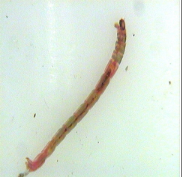Life After Water Series: Life of the Midge
Life of the Midge: the ultimate recycler
The midge is a fascinating benthic macroinvertebrate that goes through a complete metamorphosis, involving the complete four stages of the life cycle; the egg, larval, pupal, and the adult stage. Today we will explore: What happens after the midge pupa leaves the safety and familiarity of the water? And how does the midge pupa transform into its adult form? To explore these questions, we’ll start at the very beginning—when the midge eggs are first laid.
Adult female midges will lay their eggs in aquatic habits and scatter them either under or over the surface of the water or on emergent vegetation in a gelatinous mass. The eggs will hatch anywhere between a few days to a month depending on the species and environmental conditions. Eggs may also stay dormant for long periods of time.
Once they have hatched the larvae will develop through four stages of transformation before becoming adults in what are called ‘instars’ and these can last 2 weeks to 4 years. The first instar is planktonic meaning the midge will float in the water column. The following instar stages will have the midge descend to the bottom of the water body. When the fourth instar reaches the end of development, the thoracic segment of the larvae will swell as the pupa layer forms.
Now in the pupal phase the pupa will seek shelter in debris, remain attached to the substrate or produce a cocoon during its transformation into an adult. The pupal stage only lasts 1-2 weeks and when the midge is ready to proceed to the adult phase it will swim to the surface of the water and the adult midge will pull itself out of its protective layer.
As an adult, emerging at the same time as hundreds of other midges, a mass of male adult midges will swarm the females and mating will occur. These swarms do not last longer than a month as in most species the adults will only live for a few days to a few weeks. During this phase adult midges will not eat, but they may drink water or nectar. Adult midges can often be confused with mosquitos, however unlike mosquitos, midges do not bite and lack scales on their wings.
Fun Fact: Midge larvae aid in the decomposition process and the recycling of nutrients, harvesting a large amount of energy from the detritus that they consume and cycling this energy back into the food chain.
Fun Fact: Some midges are known as blood midges because of their distinctive red coloration. They contain the blood pigment hemoglobin which allows them to absorb oxygen from the water more efficiently, allowing them to survive in heavily polluted waters with low oxygen levels.
Interested in learning more about benthic macroinvertebrates and how they can be used to measure the health of rivers and streams? Be sure to follow EcoSpark’s social media to stay updated on our Changing Currents program and our other citizen science and environmental education programs.
References
Banasch, D. (2018). Insect Life Cycles. Retrieved from: http://www.albertabowriver.com/insect_life_cycles.htm
Carina holds a Bachelor of Honors in Environmental Studies and a diploma in Ecosystem Technology, both of which developed her interest in using geographic information systems to communicate about complex issues, such as climate change. In her role as Lead Environmental Educator, Carina designs geospatial education tools for EcoSpark’s citizen science programs. When outdoors in the field, you will often find her streamside identifying aquatic critters, communicating her enthusiasm for the outdoors, and demonstrating her dedication to stewardship practices with youth and adults throughout the GTA.



